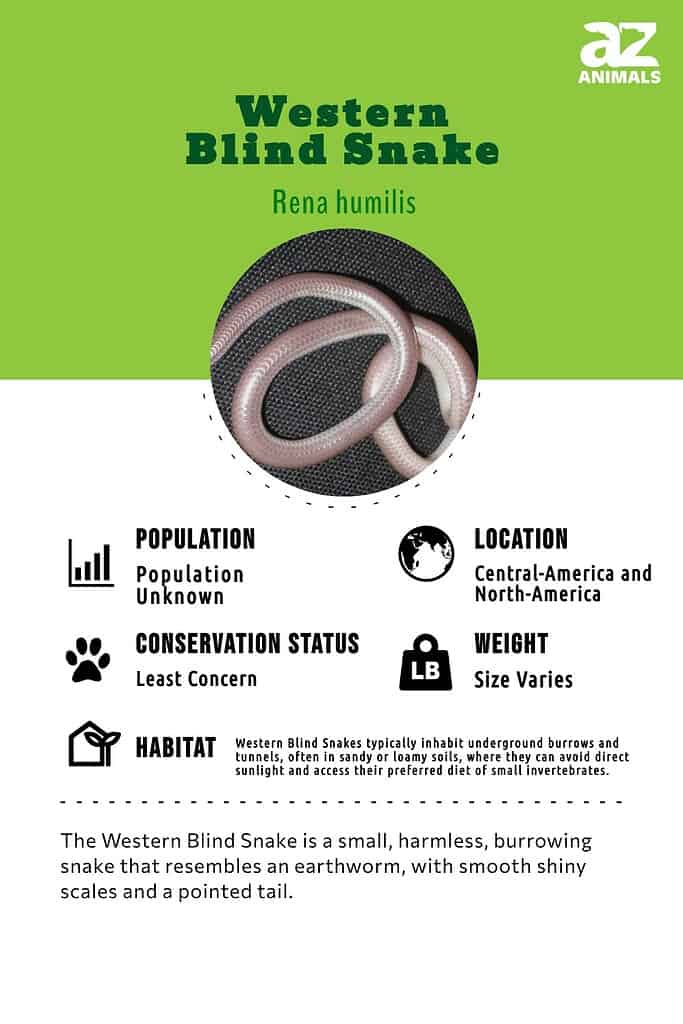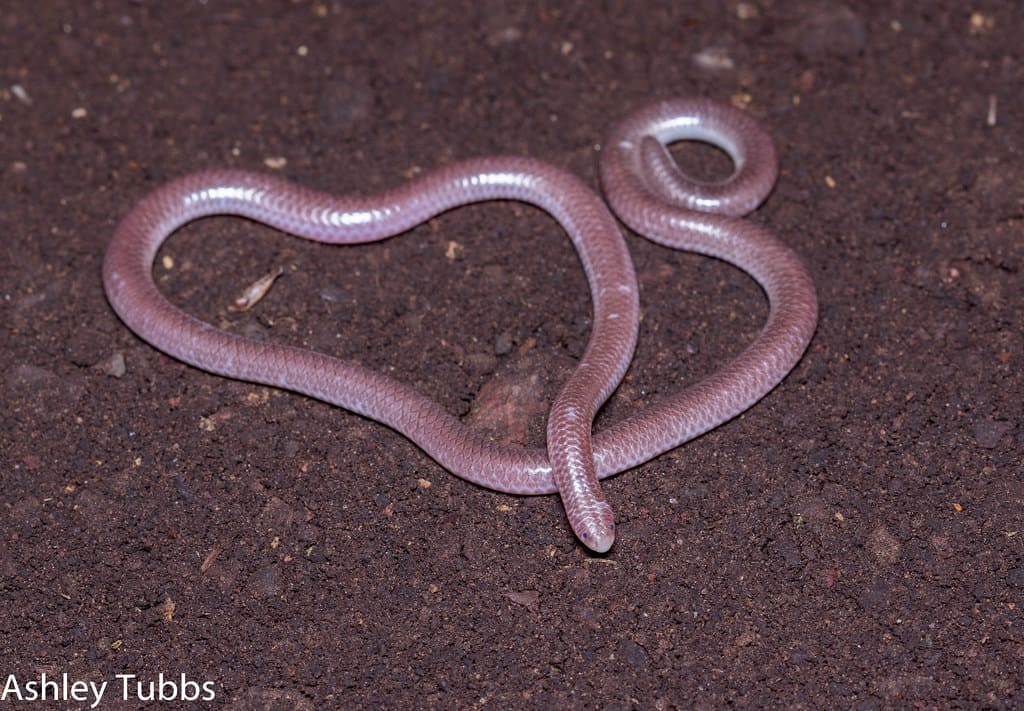Western Blind Snake
Rena humilis
Western blind snakes are flourescent in black light!
Advertisement
Western Blind Snake Scientific Classification
- Kingdom
- Animalia
- Phylum
- Chordata
- Class
- Reptilia
- Order
- Squamata
- Family
- Leptotyphlopidae
- Genus
- Rena
- Scientific Name
- Rena humilis
Read our Complete Guide to Classification of Animals.
Western Blind Snake Conservation Status
Western Blind Snake Facts
- Prey
- Ants and termites and their larvae, small invertebrates such as spiders, millipedes, and centipedes
- Fun Fact
- Western blind snakes are flourescent in black light!
- Most Distinctive Feature
- They look like unusually long earthworms.
- Distinctive Feature
- They have an attractive metallic sheen.
- Other Name(s)
- Slender blind snake and Western thread snake
- Habitat
- In scrublands and desert areas where the soil is loose, rocky outgrowths, crevices, and spaces beneath debris
- Diet
- Carnivore
- Lifestyle
- Nocturnal
Western Blind Snake Physical Characteristics
- Color
- Brown
- Purple
- Silver
- Pink
- Skin Type
- Scales
- Venomous
- No
- Aggression
- Low
View all of the Western Blind Snake images!

The snake that looks like an earthworm
The western blind snake is a member of one of the oldest snake families. They are so ancient that they still have remnants of pelvic girdles that you can see as tiny spurs if you flip the snake over. Harmless to humans but murder on colonies of ants and termites, these exceedingly slender snakes spend much of their lives underground and out of sight.
Five Amazing Facts About Western Blind Snakes

Western blind snakes look like extremely long earthworms.
©A-Z-Animals.com/ashleytisme
Here are five facts about the western blind snake.
- It is fluorescent in black light.
- It can live as deep as 66 feet underground.
- Its other names are a western slender blind snake and a western thread snake.
- They also have vestigial femurs, leftovers from lizard ancestors.
- Western blind snakes are so primitive that some biologists think they are not proper snakes and should be in their own category.
Where To Find Western Blind Snakes
Western blind snakes are found in northern Mexico and north into Arizona, Utah, southern California, and Texas. It prefers habitats where the soil is loose, so it would be most often found in scrublands and desert areas. Other preferred habitats are rocky outgrowths, crevices, and spaces beneath debris.
Evolution and Origins
Blind snakes, despite having eyes, reside mainly underground in tunnels, rendering their vision almost unnecessary; they mostly rely on ant and termite colonies and their larvae as food sources, as they can be readily found within the subterranean tunnels they inhabit.
Blind snakes have thick, overlapping scales on their backs, which is a distinct feature that sets them apart from other snake families, as some snakes have scales that are barely overlapping or not at all, and this overlap of thick scales provides a robust protective covering for the blind snakes.
Due to their small, worm-like appearance, blind snakes are frequently confused with earthworms, and they possess a forked tongue and smooth scales that facilitate their movement through the soil; they are typically pink or grey in color and lack broad belly scales.
Scientific Name
The western blind snake’s scientific name, Rena humilis, comes from the Latin words for “kidney” which is ren, and “of the earth,” which is humilis. This describes the snake’s reddish color and its habit of burrowing through soft earth. Another scientific name is Leptotyphlops humilis. The genus name comes from the Greek word for “slender” which is leptos, typhlos, which means “blind” and ops, which means “eye.” There are six subspecies:
- R. h. cahuilae
- R. h. humilis
- R. h. levitoni
- R. h. lindsayi
- R. h. tenuiculus
- R. h. utahensis
The Different Types
R. h. cahuilae is the desert thread snake, while R. h. humilis is the southwestern blind snake and also the nominate species. As its name suggests. R.h. utahensis is called the Utah blind snake, and it is found in the western part of the state’s Washington County.
Appearance and Description
Your first impression of the western blind snake is that it is an unusually long and unusually squiggly earthworm. It may even seem, compared to an earthworm, unusually thin. Some blind snakes are no wider than a shoelace. But if you pick it up and examine it, you’ll notice that it has eyes.
They are tiny and only good for telling light from dark. It also has jaws, with the lower one being a bit undershot. Its coloration is purplish, brownish-gray, or pink above and light below, and if you really look, you’ll see that it is covered with tightly packed hexagonal scales that are all the same size.
They also have a lovely metallic sheen or oily look to them. If you’re still not sure whether you have a blind snake or an earthworm, shine a black light on it. The blind snake will actually glow.
The western blind snake is also unlike an earthworm in that it has a spur on the end of its tail. This spur isn’t to sting you but to help it dig. The bones in the little snake’s skull are also more fused together than the bones of the skulls of other snakes. The skull bones in other snakes have to separate to accommodate swallowing meals much larger than their heads. The blind snake’s head also helps it dig.
Small insects such as ants and termites, their eggs and larvae, and other small invertebrates such as spiders, millipedes, and centipedes are staples of its diet. By the way, only its lower jaw has teeth. Because the blind snake’s skull is more solid, it might have to tear larger prey to pieces before eating it.

Western blind snakes have tiny eyes and can distinguish light from dark.
©
Venom: How Dangerous Are They?
Western blind snakes are not venomous and are completely harmless to humans. If they are poisonous, they are only poisonous to their prey.
Behavior and Humans
It is unusual for humans to come into contact with blind snakes regularly, for they not only live much of their lives underground or in cracks and crevices but are nocturnal. They are most likely to be seen when it rains, and they are washed up to the surface.
People also uncover them when they’re digging, and pet cats sometimes find them and bring them home. One fascinating thing about the Utah blind snake is that screech owls pick it up to bring to their nest. They’re not brought there for food but to clean up the mites and other vermin that infest the nest and may hurt the owlets.
Western blind snakes not only have a diet of ants and termites and their young but sometimes live in their nests. Since they can’t see well, they find an ant or termite nest by following the train of chemicals left by the insects.
Once in the nest, the snakes use their lower jaw to shovel the prey into their mouths, and unlike other snakes, which can go without food for a long time, the blind snake eats pretty regularly. They fend off attacks by ants and termites by arranging their scales in a way that makes it hard for the insect to grab them in their jaws. The snake also empties its bowels, which the insects find off-putting.
When the snake is threatened it coils up tightly and, as it does under ant or termite attack, empties its bowels. It may try to poke the attacker with its spur or roll over and play dead, a tactic called thanatosis. A snake this little and harmless does have a lot of predators, including spiders, birds, all kinds of mammals, larger snakes, and fish.
The western blind snake’s conservation status is least concern, and its population is stable.
Western blind snakes mate in the spring, and in the summer the females lay between two and six eggs underground. Blind snakes may lay their eggs in a communal nursery. They are only 0.625 inches long, and their mother guards them until they hatch. The hatchlings are only 3.5 inches long. Scientists are not quite sure about the lifespan of this snake.
View all 108 animals that start with WWestern Blind Snake FAQs (Frequently Asked Questions)
Are western blind snakes poisonous?
Western blind snakes are not poisonous.
Can you have a western blind snake as a pet?
It is possible to have a western blind snake as a pet, though they are not the most charismatic of reptiles. If you can supply the food they like, a small blind snake can be happy in an artificial habitat made of a container with a substrate of soil, gravel, and mulch.
What do Western blind snakes eat?
In the wild blind snakes eat ants, termites, and other small invertebrates. They have also been known to have the frass (excrement) of caterpillars as part of their diet.
Are Western blind snakes really blind?
The eyes of the western blind snake aren’t completely blind but can detect light and dark.
How long are Western blind snakes?
These snakes grow to be between 6 and 12 inches long.
Thank you for reading! Have some feedback for us? Contact the AZ Animals editorial team.
Sources
- NatureServe Explorer, Available here: https://explorer.natureserve.org/Taxon/ELEMENT_GLOBAL.2.105688/Rena_humilis
- Wild About Utah, Available here: https://wildaboututah.org/blind-snakes/
- Red Cliffs Desert Reserve, Available here: http://www.redcliffsdesertreserve.com/western-blind-snake
- Arizona-Sonora Desert Museum, Available here: http://www.desertmuseum.org/books/nhsd_lepto.php
- Wikipedia, Available here: https://en.wikipedia.org/wiki/Rena_humilis
- Reptile Database, Available here: https://reptile-database.reptarium.cz/species?genus=Rena&species=humilis
- California Herps, Available here: http://www.californiaherps.com/snakes/pages/r.h.cahuilae.html
- Reptiles Magazine, Available here: https://reptilesmagazine.com/blind-snakes/

















